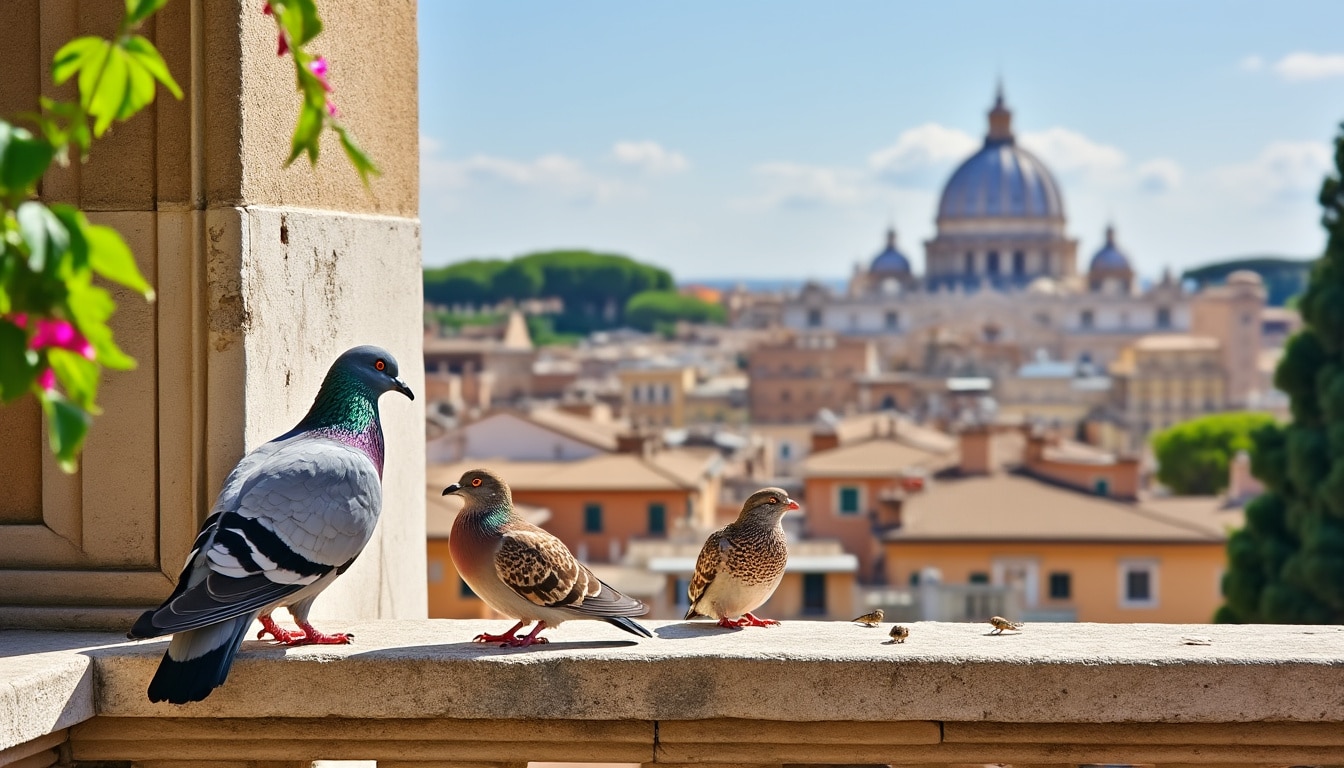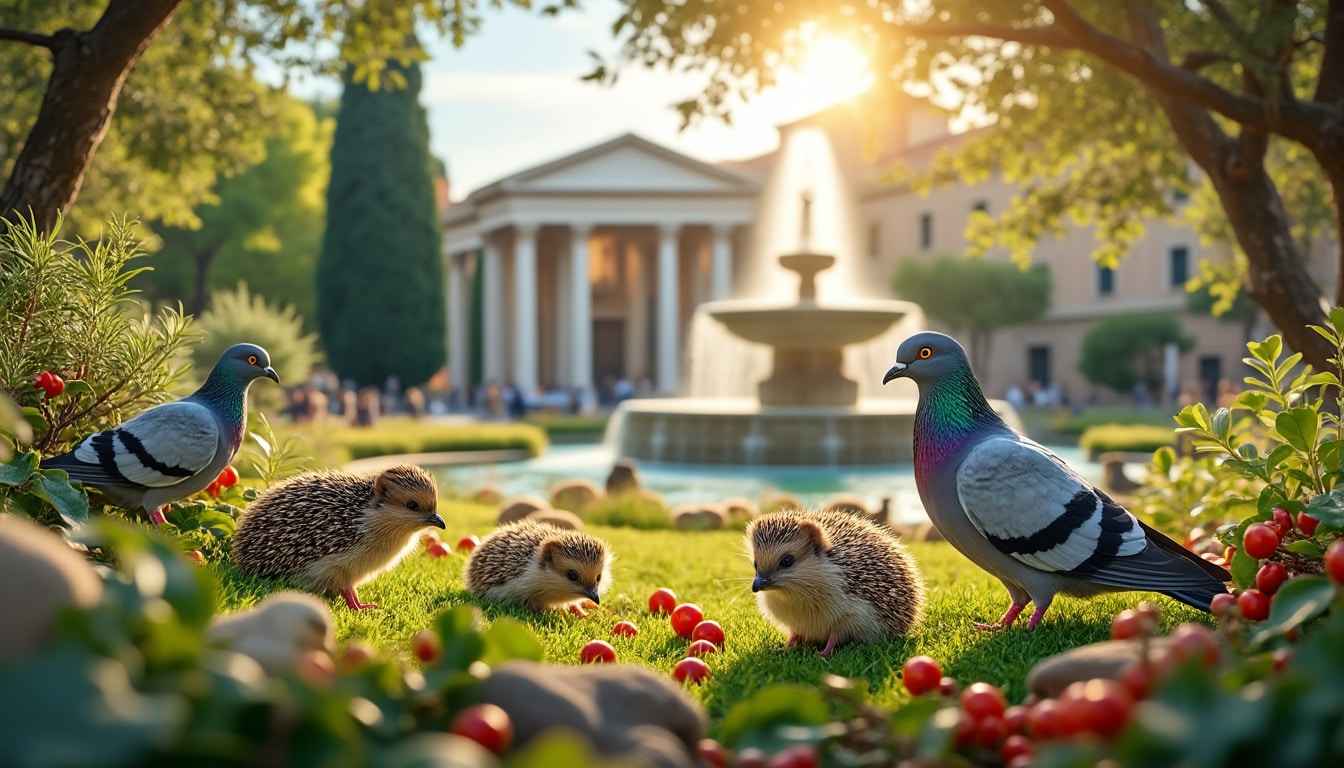Rome is renowned for its history, art, and culinary delights, but the Eternal City also boasts a vibrant natural world waiting to be explored. From birdwatchers delighting in the flurry of feathers to wildlife enthusiasts witnessing wild boars and hedgehogs, Rome offers a surprising array of fauna amidst its urban landscape. As 2025 unfolds, discover how green spaces, sustainable tours, and thriving biodiversity are shaping the experience of Nature and wildlife in Rome.
Birds of Rome: The Aerial Spectacle Over the Eternal City
When considering Rome, one might conjure images of its ancient architecture and rich cultural tapestry, yet above the skyline of this historic city soars a lesser-known delight: its bustling avian population. With over 300 bird species either residing in or migrating through Rome, the city is a paradise for birdwatchers and nature lovers alike.
The common house sparrow, rock dove, and the charming European robin are frequent sights, often seen flitting between ancient ruins and cozy city parks. However, more exotic species like the hoopoe and bee-eater, with their vivid plumage, provide a splash of nature’s vibrant palette against Rome’s urban backdrop.
One of the most remarkable success stories in Rome’s bird kingdom is that of the peregrine falcon. Once dwindling in numbers, these majestic raptors have staged a comeback, their populations revitalized thanks to ongoing conservation efforts aimed at securing their habitats amidst the cityscape.
Birdwatching hotspots include the lush expanses of the Borghese Gardens and the tranquil Villa Ada. These spaces offer a verdant escape where the symphonies of chirping and flapping wings create a serene atmosphere. Even iconic landmarks like the Colosseum and Roman Forum add historical grandeur to birdwatching adventures.
- 🪶 Borghese Gardens: Ideal for spotting diverse bird life.
- 🏺 Colosseum & Roman Forum: Unique historical backdrop for wildlife enthusiasts.
- 🌳 Villa Ada: Serene oasis for birdwatchers.
Rome’s avian residents play a critical role in the ecosystem, acting as pollinators, seed dispersers, and insect controllers, making them vital to the city’s ecological balance. To support this, conservationists have initiated various programs and educational workshops to engage both locals and tourists in sustainable practices.

Exploring Different Species and Their Habitats
The remarkable diversity of Rome’s bird species is supported by the variety of habitats available throughout the city. Predominantly, green spaces provide critical refuge where these birds can feed, breed, and thrive away from urban dangers.
A significant conservation initiative focuses on creating and maintaining bird-friendly environments, which includes planting native flora to attract and support these feathered friends. Educating the public on fostering such environments has seen an increase in private gardens also contributing to this green network.
| Common Species | Exotic Species | Conservation Highlights |
|---|---|---|
| House Sparrow | Hoopoe | Peregrine Falcon Recovery |
| European Robin | Bee-Eater | Habitat Restoration Projects |
| Rock Dove | – | Educational Workshops |
Mammals in Rome: Urban Wildlife and Conservation Challenges
Beneath Rome’s expansive skies and amidst its lush green parks, curious eyes might catch a glimpse of the captivating mammal life that coexists within the city. From the humble hedgehog scuttling through foliage to the imposing wild boar roaming urban streets, Rome is a city where wildlife thrives alongside human activities.
Wild boars, in particular, have made headlines as their interactions with humans become more frequent. These moments are usually less aggressive than they sound and more about boars foraging for food in urban areas, particularly rummaging through garbage—a behavior leading to both amusement and concern among city dwellers.
Conservation efforts focus on balancing the thriving mammal populations with urban life. This includes implementing robust management strategies aimed at mitigating conflicts while securing habitats. Educational campaigns encourage the public to adopt practices that are harmonious with both urban living and wildlife conservation.
- 🐗 Wild Boar Safety: Awareness programs reducing human-wildlife conflicts.
- 🦔 Hedgehog Habitats: Creating safe passageways and dedicated sanctuaries.
- 🦊 Urban Foxes: Understanding their role in the city’s ecosystem.
The Impact of Urban Development on Wildlife Habitats
Rome’s mammals have shown remarkable adaptability to urban life, but this adaptation brings to light the pressing issue of habitat disruption due to urban expansion. Developing cities often risk the natural landscapes which species rely on for survival.
Understanding the critical need for sustainable urban planning, Rome has embarked on initiatives such as nature corridors within the city. These carefully planned green pathways allow animals to move safely across habitats, reducing road accidents and promoting genetic diversity among populations.
| Mammal Species | Threats | Conservation Measures |
|---|---|---|
| Wild Boar | Urban Encroachment | Safe Zones and Management |
| Hedgehog | Traffic Accidents | Sanctuaries and Awareness |
| Red Fox | Habitat Loss | Eco-Friendly Planning |
Reptiles and Amphibians: Cold-Blooded Residents of Rome
Rome’s moderate climate serves as an inviting home for an often overlooked yet fascinating group of residents: reptiles and amphibians. With their cool, impassive aesthetics, these creatures add a unique allure to Rome’s biodiversity.
Among the city’s more prominent risks is the impact urban developments pose on their natural habitats. However, conservation initiatives aim to protect not only these species but also the habitats they thrive in. This involves a concerted effort to design and maintain open green spaces that cater to their ecological requirements.
- 🦎 Common Wall Lizard: Adapting to city life across stone walls and gardens.
- 🐍 Aesculapian Snake: Sign of a healthy ecosystem.
- 🐸 Green Tree Frog: A colorful presence in park wetlands.
Conservation and Education Efforts for Herpetofauna
Efforts to sustain Rome’s herpetofauna populations encompass both conservation actions and public education. Programs are geared towards creating suitable urban environments that allow these species to flourish without disruption from the bustling city life.
Citizens are encouraged to participate in these efforts by embracing ecological-friendly practices such as refraining from using harmful pesticides, contributing garden space to support local biodiversity, and joining volunteer groups focused on habitat conservation.
| Species | Common Habitats | Conservation Efforts |
|---|---|---|
| Green Tree Frog | Wetlands, Gardens | Habitat Protection |
| Common Wall Lizard | Stone Walls, Urban Parks | Sustainable Space Planning |
| Aesculapian Snake | Forested Areas | Educational Programs |
Aquatic Life in Rome’s Waters: A Hidden Underwater World
Beneath Rome’s surface, along the serpentine flow of the River Tiber and the city’s peaceful lakes, lies an ecosystem teeming with aquatic life. From the quicksilver flicker of fish swimming upstream to small crustaceans scurrying along riverbeds, Rome offers a bounty sure to entice nature enthusiasts.
Notable residents of these waterways include the elusive European eel, the versatile mullet, and the industrious freshwater crayfish. These species not only contribute to the myriads of the aquatic food web but also serve as indicators of environmental health.
- 🐟 European Eel: Conservation success amidst pollution challenges.
- 🦞 Freshwater Crayfish: Maintaining the river’s biological integrity.
- 🐠 Mullet: An adaptable species in shifting environments.
Conserving Rome’s Aquatic Ecosystems
Efforts to safeguard the quality of Rome’s waters are as diverse as the species they aim to protect. Strict regulations and cleanup operations are frequently conducted to mitigate pollution and support the thriving aquatic biodiversity. These actions ensure that the city’s water bodies remain healthy and sustainable.
Public involvement is crucial in these conservation efforts. Whether through participating in local cleanup initiatives, educating others about the significance of aquatic health, or supporting policies aimed at reducing pollution, individuals can make a profound impact on sustaining Rome’s underwater ecosystems.
| Aquatic Species | Environmental Role | Conservation Challenges |
|---|---|---|
| European Eel | Indicator Species | Pollution |
| Freshwater Crayfish | Bioindicators | Habitat Disruption |
| Mullet | Diet Variation | Water Quality |
Insects and Arachnids: Ecosystem Heroes of Rome
As tiny as they may be, insects and arachnids command a critical role in Rome’s ecosystem. These creatures often go unnoticed, yet their contributions to pollination, soil aeration, and decomposition are indispensable.
Among these unsung heroes, ants play a substantial part in disrupting organic matter and fertilizing the soil. Meanwhile, colorful species of butterflies and moths, flitting through parks and gardens, add beauty and assist in pollinating a range of floral species.
Despite their beneficial roles, the battle against pests like mosquitoes continues to draw focus towards creating balance within the ecosystem while combating challenges posed by climate change and urbanization.
- 🐜 Ants: Essential contributors to soil health and plant growth.
- 🦋 Butterflies: Fluttering pollinators throughout the cityscape.
- 🕷️ Spiders: Natural controllers of pest populations.
Supporting Urban Biodiversity through Insects and Arachnids
Conserving urban biodiversity involves addressing the challenges of habitat loss and climate impacts on these tiny creatures. Initiatives focus on maintaining diverse planting within city landscapes that provide crucial habitats and nourishments for these vital organisms.
Educational campaigns aimed at promoting eco-awareness encourage minimizing the use of pesticides, fostering organic gardening practices, and planting pollinator-friendly plants. These collective efforts ensure Rome continues to pulse with natural vitality, benefiting from the crucial Earthly work of its smallest inhabitants.
| Species | Ecological Impact | Challenges |
|---|---|---|
| Ants | Soil Health | Habitat Loss |
| Butterflies | Pollination | Pesticide Use |
| Spiders | Pest Control | Urban Disturbance |
FAQs on Nature and Wildlife in Rome
-
Q: What are the best places in Rome for wildlife tours?
A: Rome’s Borghese Gardens, Villa Ada, and the River Tiber offer excellent opportunities for wildlife sightings and eco tours.
-
Q: Is it safe to encounter wild boars in Rome?
A: Generally, wild boars avoid confrontation. It’s important to maintain a safe distance and secure trash to help manage urban interactions.
-
Q: How can tourists support conservation efforts in Rome?
A: Tourists can support by engaging in eco-friendly activities, supporting local conservation organizations, and participating in educational programs.

